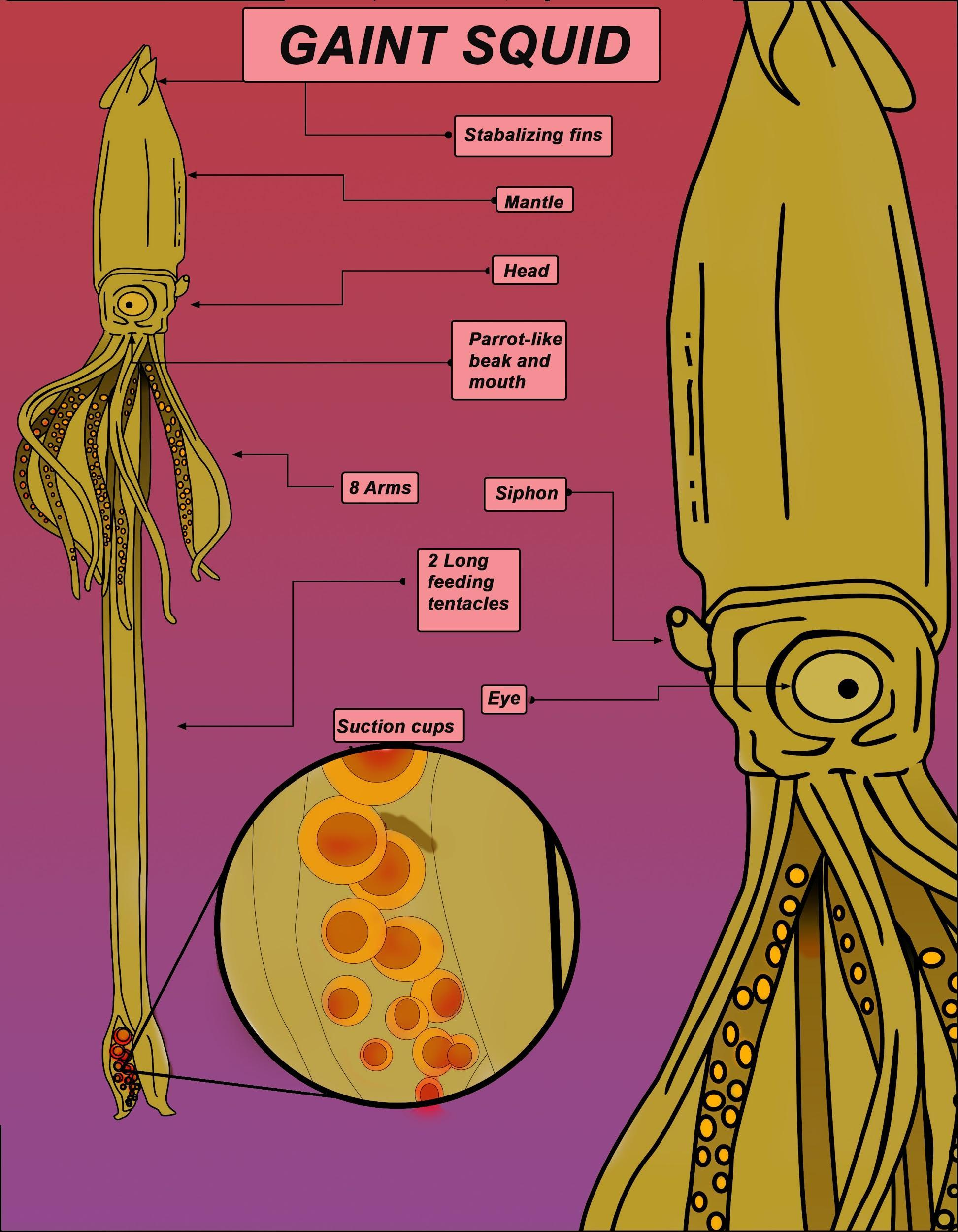
The diameter of Architeuthis is
a) 5 cm - 7.5 cm
b) 12 cm - 17.5 cm
c) 27 cm - 37.5 cm
d) 45 cm - 57.5 cm
Answer
467.7k+ views
Hint: Architeuthis dux which is also called the giant squid is the biggest known cephalopod, the biggest known mollusks, and likely the biggest spineless creatures ever known to exist in the seas. These squid species are firmly identified with snails, shellfishes, and even slugs: they are largely mollusks, which are characterized by their delicate bodies. A portion of these delicate bodies is encased in hard shells, for example, shellfishes and snails, however not the squids.
Complete Answer:
A monster squid's body may look quite basic: Like different squids and octopuses, it has two eyes, a bill, eight arms, two taking care of arms, and a channel (likewise called a siphon) .
The head holds eyes the size of supper plates - the biggest in the collection of animals. At 1 foot (30 centimeters) in breadth, these gigantic eyes ingest more light than their littler partners would, permitting the squid to witness bioluminescent prey - or sight hunters prowling - in obscurity. The squid's intricate cerebrum, which is small contrasted with its body, is formed like a doughnut. food into smidgens a developmental need.

Monster squid can grab prey up to 33 feet (10 meters) away by shooting out their two taking care of arms, which are tipped with many incredible sharp- toothed suckers. These taking care of limbs are extremely long, regularly multiplying the absolute length of the monster squid all alone.
So the correct answer is' 27 cm - 37.5cm.
Additional Information:
- ARMS AND BEAK: Eight thick arms dotted with 2- inch wide- toothed suckers manage prey from the taking care of arms to a sharp nose in the focal point of the arms, where the prey is cut into reduced down pieces. These nibbles are additionally cut and ground by the radula, a tongue- like organ secured with columns of teeth, that is inside the squid's snout.
BODY AND FUNNEL: The fundamental aspect of the body, or mantle, contains all the essential organs. Also, on the body's underside is the channel—an astounding multipurpose instrument. By siphoning water and different liquids through the channel, the squid utilizes it to breathe out, remove squander, lay eggs, spurt ink, and travel through the water by fly impetus.
Note: It is sure that Architeuthis has a plenitude of developmental family members. The sea holds an expected 500 types of squid—and practically those are in a similar ordered request as the goliath squid, called Oegopsina. Some are shockingly small—just around 1 inch (2.5 centimeters) long. Others are amazingly enormous, including the goliath squid (Mesonychoteuthis hamiltoni) , which can develop to be much greater than the monster squid, arriving at 45 feet (14 meters) .
Complete Answer:
A monster squid's body may look quite basic: Like different squids and octopuses, it has two eyes, a bill, eight arms, two taking care of arms, and a channel (likewise called a siphon) .
The head holds eyes the size of supper plates - the biggest in the collection of animals. At 1 foot (30 centimeters) in breadth, these gigantic eyes ingest more light than their littler partners would, permitting the squid to witness bioluminescent prey - or sight hunters prowling - in obscurity. The squid's intricate cerebrum, which is small contrasted with its body, is formed like a doughnut. food into smidgens a developmental need.

Monster squid can grab prey up to 33 feet (10 meters) away by shooting out their two taking care of arms, which are tipped with many incredible sharp- toothed suckers. These taking care of limbs are extremely long, regularly multiplying the absolute length of the monster squid all alone.
So the correct answer is' 27 cm - 37.5cm.
Additional Information:
- ARMS AND BEAK: Eight thick arms dotted with 2- inch wide- toothed suckers manage prey from the taking care of arms to a sharp nose in the focal point of the arms, where the prey is cut into reduced down pieces. These nibbles are additionally cut and ground by the radula, a tongue- like organ secured with columns of teeth, that is inside the squid's snout.
BODY AND FUNNEL: The fundamental aspect of the body, or mantle, contains all the essential organs. Also, on the body's underside is the channel—an astounding multipurpose instrument. By siphoning water and different liquids through the channel, the squid utilizes it to breathe out, remove squander, lay eggs, spurt ink, and travel through the water by fly impetus.
Note: It is sure that Architeuthis has a plenitude of developmental family members. The sea holds an expected 500 types of squid—and practically those are in a similar ordered request as the goliath squid, called Oegopsina. Some are shockingly small—just around 1 inch (2.5 centimeters) long. Others are amazingly enormous, including the goliath squid (Mesonychoteuthis hamiltoni) , which can develop to be much greater than the monster squid, arriving at 45 feet (14 meters) .
Recently Updated Pages
Glucose when reduced with HI and red Phosphorus gives class 11 chemistry CBSE

The highest possible oxidation states of Uranium and class 11 chemistry CBSE

Find the value of x if the mode of the following data class 11 maths CBSE

Which of the following can be used in the Friedel Crafts class 11 chemistry CBSE

A sphere of mass 40 kg is attracted by a second sphere class 11 physics CBSE

Statement I Reactivity of aluminium decreases when class 11 chemistry CBSE

Trending doubts
10 examples of friction in our daily life

Difference Between Prokaryotic Cells and Eukaryotic Cells

One Metric ton is equal to kg A 10000 B 1000 C 100 class 11 physics CBSE

State and prove Bernoullis theorem class 11 physics CBSE

What organs are located on the left side of your body class 11 biology CBSE

Define least count of vernier callipers How do you class 11 physics CBSE




